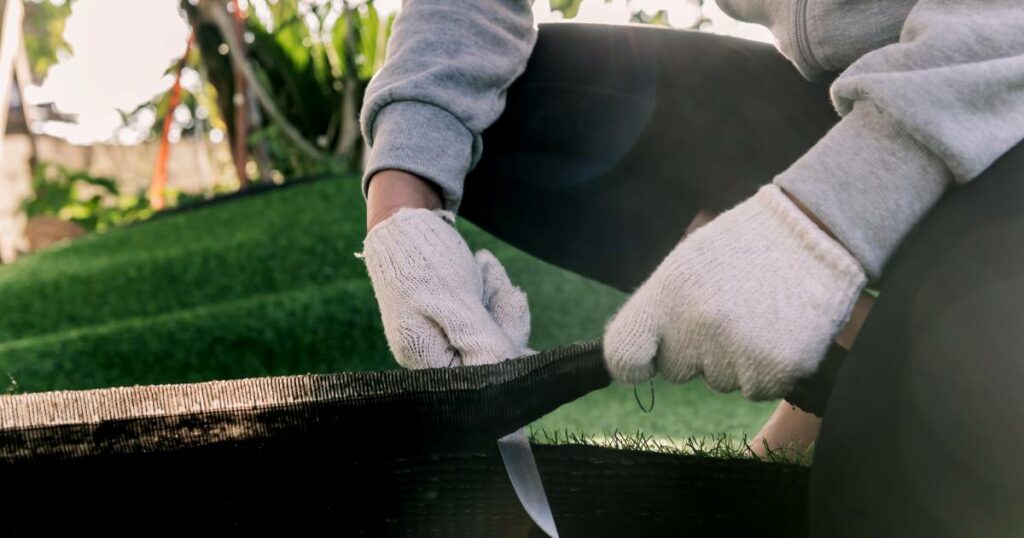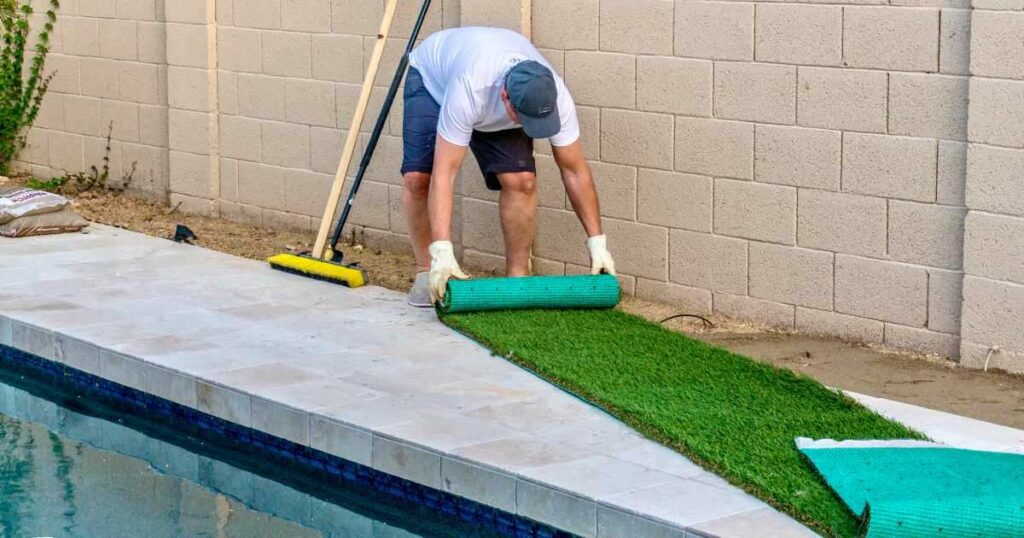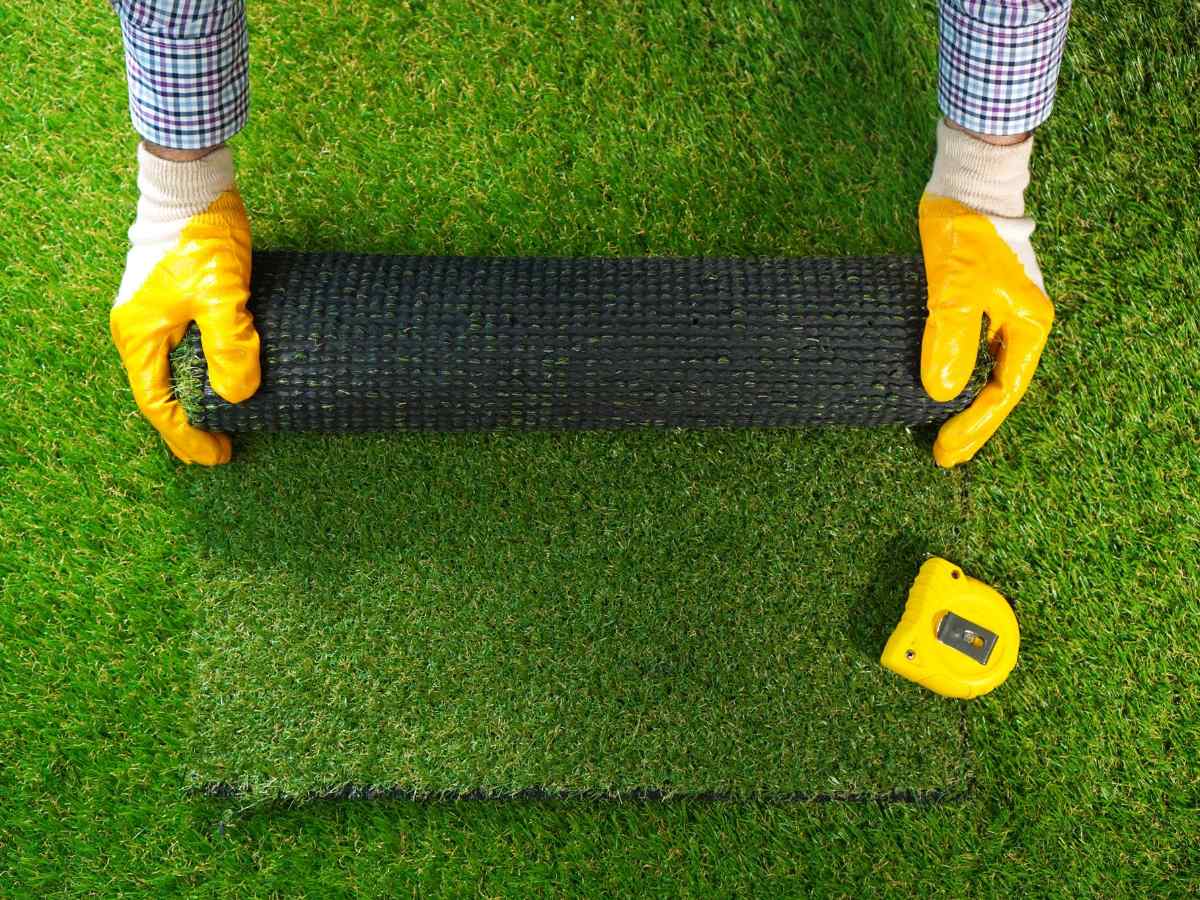An artificial turf is a synthetic form of natural grass designed primarily for sports fields and residential landscapes. Made of durable fibers and backed by a tough base, it offers consistent performance, reduced water usage, and year-round aesthetics.
These advantages eliminate the challenges of regular mowing, watering, and fertilization. However, proper care is essential to maintain artificial turf’s longevity and vibrant look. Regular brushing, timely cleaning of spills, and occasional rinsing can prevent matting and accumulation of debris.
Proper maintenance extends the turf’s lifespan and ensures its users’ safety. It’s best to recognize that while artificial turf minimizes upkeep compared to natural grass, it doesn’t eliminate it.
Tip 1: Regular Brushing
Regular brushing is an aspect of artificial turf maintenance. To brush artificial turf, use a broom with synthetic bristles or a specialized turf brush and gently sweep against the grain of the grass. This process helps to lift and fluff up the fibers, ensuring they remain upright and maintain their natural appearance.
Regular brushing offers numerous benefits. Most notably, it prevents the fibers from becoming matted and flat, especially in high-traffic areas. Additionally, brushing ensures an even, uniform appearance across the surface, making it more aesthetically pleasing.

Tip 2: Removing Debris
Regularly removing debris from artificial turf is essential to preserving its appearance and functionality. Leaves, twigs, and other detritus can accumulate on the surface, leading to mold growth, reduced drainage capabilities, and an unkempt appearance. This debris can also trap moisture against the fibers, potentially accelerating wear and tear.
To effectively remove debris without damaging the turf, use a soft-bristle broom or a leaf blower set to a moderate setting. Gently sweep or blow away the debris to prevent any physical damage to the fibers. Consider using a garden or specialized turf vacuum for smaller debris or more thorough cleaning.
Ensure that the tools used are designed for or safe to use on artificial turf to avoid causing unintentional damage. Regularly attending to debris will maintain the turf’s pristine look and enhance its lifespan.
Tip 3: Treating Stains and Spills
When it comes to maintaining artificial turf, dealing with stains and spills can be challenging. Common stains and spills on artificial turf include pet urine, food and drink spills, mud, and oil. Act quickly and blot up as much urine as possible for pet urine stains is important. Then, apply water and white vinegar solution to the stained area. Let it sit briefly before blotting it up with a clean cloth.
Remove any excess debris for food and drink with a mild soap and water solution. For mud, allow the mud to dry completely. Sprinkle a generous baking soda onto the affected area for oil stains and let it sit for a few hours before vacuuming.

Tip 4: Proper Watering of Artificial Turf
Artificial turf requires less maintenance and needs proper care. One essential practice is watering. While it may seem counterintuitive, watering synthetic grass has twofold benefits. Firstly, during hot days, a brief water session can significantly reduce the turf’s temperature, making it comfortable for activities and preventing potential burns. Secondly, occasional watering helps cleanse the surface of dust, pollen, and other small debris, maintaining its fresh appearance and functionality.
Regarding frequency and duration: A quick 5-10 minute sprinkle can cool the turf in scorching conditions. For cleaning, a deeper watering every few weeks or monthly can wash away accumulated detritus. Adjust based on local conditions and usage.
Tip 5: Weed Control of Artificial Turf
Artificial turf, while a low-maintenance alternative to natural grass, isn’t completely exempt from the menace of weeds. Vulnerabilities often appear at the edges, seams, or tiny openings in the turf, providing an avenue for weeds to take root and mar the turf’s appearance, even impacting its longevity. The key to protection lies in the foundation. A solid weed barrier during installation can offer a robust defense. However, vigilance remains essential.
Regular inspections, especially around edges and seams, can catch early infestations. Should a stray weed appear, immediate removal is crucial to prevent further intrusion. For persistent issues, careful application of herbicides, ensuring no damage to the turf, might be necessary. Extra attention to the turf’s edges, ensuring they’re well-sealed and maintained, can be the final bastion against these unwelcome intruders.
Tip 6: Protecting Against Pet Waste
While artificial turf is a favorite for many pet owners due to its resilience and ease of maintenance, pet waste can pose a challenge. The acids and salts in urine have the potential to discolor the grass, and solid wastes, if not addressed, can mar the turf’s appearance and cleanliness. Immediately removing solid waste is important, followed by a thorough rinse to wash away residues.
For added cleanliness, especially after urination or if residues persist, enzymatic cleaners designed for pet waste can be used. They not only ensure a clean turf but also help eliminate odors. Training pets to use specific areas for their needs can also help preserve the turf’s appearance. Coupled with regular maintenance like brushing, these strategies can ensure that the turf remains inviting even in homes with furry family members.

Tip 7: Repairs and Maintenance
While artificial turf is celebrated for its resilience, ensuring its longevity requires vigilant maintenance and timely repairs. Addressing minor issues promptly can prevent them from snowballing into costly replacements or extensive damage. Regular self-inspections can help identify wear, tears, or issues with seams. For minor problems, DIY solutions like patch kits can be effective, especially when instructions are followed meticulously.
Seam ruptures can often be fixed with quality adhesives, ensuring the edges bond firmly. However, when faced with larger damages or if in doubt, it’s wise to seek professional assistance. Experts can provide efficient repairs and advice on preventing future issues. Periodic consultations or maintenance checks by professionals can also be a proactive approach to safeguarding the turf and maximizing its lifespan.
Tip 8: Avoiding Heavy Furniture or Equipment
Artificial turf, while durable, can suffer under the weight of heavy furniture or equipment. Such weight can flatten the grass fibers, leading to an uneven appearance, or even damage the underlying structure, causing permanent indentations. It’s vital to distribute weight evenly to enhance outdoor spaces with furniture or other amenities. Opt for furniture with wide bases or feet that can spread the load across a larger turf area.
If using heavy equipment temporarily, consider placing a protective layer, like a mat or board, as a buffer between the turf and the object. Rotating or shifting the position of furniture occasionally can also prevent prolonged pressure on one spot. If furniture must be a permanent fixture, it’s worth investing in specialized turf pads or stands designed to host weight without compromising the grass beneath.

Tip 9: Regular Inspections
Regular inspections are needed to preserve artificial turf’s lush appearance and durability. These routine checks serve as an early-warning system, allowing minor issues to be spotted and addressed before they morph into more extensive, costlier problems. Checking the surface for unevenness or indentations can indicate underlying damage. Seams, a common trouble spot, should appear tightly bonded without signs of separation.
The fibers should stand upright without significant flatness, indicating undue pressure or wear. Discolorations might include chemical reactions, mold, or plain wear and tear. Also, regular debris removal, like leaves or sharp objects, prevents potential damage. In essence, by frequently checking and tending to these details, homeowners can ensure their artificial turf remains vibrant and problem-free for years.
Tip 10: Hiring Professionals for Deep Cleaning
While regular home maintenance of artificial turf is essential, there’s undeniable value in periodic professional deep cleaning. Professionals have specialized equipment and solutions that can rejuvenate turf, tackling deep-seated dirt, stubborn stains, and bacteria that general cleaning might miss. This enhances the turf’s appearance and can extend its lifespan.
When selecting a turf cleaning service, a few considerations are paramount. Seek out companies with track records supported by positive reviews or testimonials. Ensure they employ environmentally-friendly cleaning agents, especially if pets or children frequent the area. Ask about their equipment: high-quality machinery can thoroughly clean without damaging the turf.
Maintain Artificial Turf
Regular maintenance of artificial turf is important for its longevity and aesthetics. While this synthetic greenery offers a low-upkeep alternative to natural grass, it’s not maintenance-free. Over time, debris, wear patterns, and minor damages can accumulate, diminishing its appeal. Proactive upkeep, such as removing debris, brushing the fibers, and addressing minor repairs, keeps the turf vibrant and extends its lifespan. Furthermore, periodic deep cleanings, preferably by professionals, can maintain artificial turf, ensuring it remains functional and visually appealing. Consistent care is the key to enjoying a pristine and lasting artificial lawn.



























